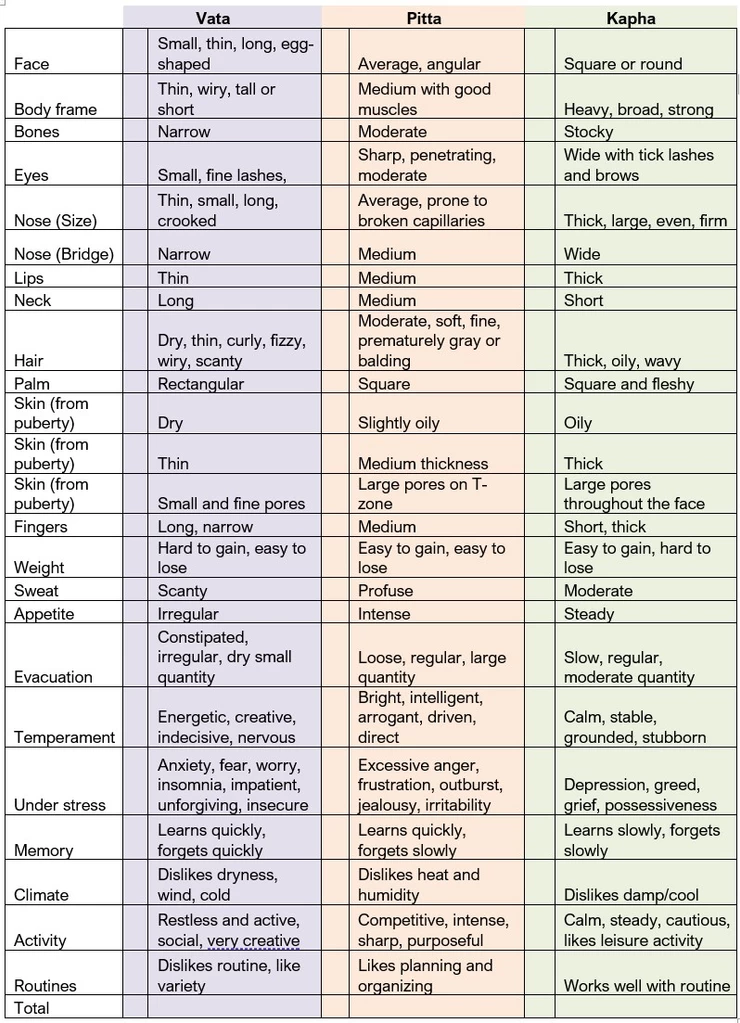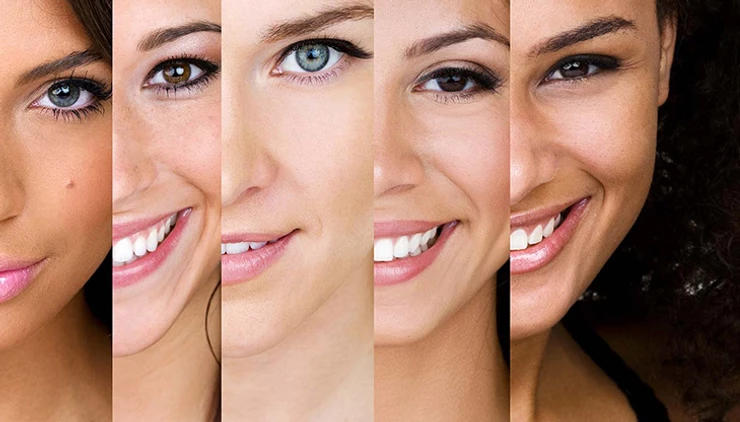Do you know your skin type? It is worth to know to keep your skin healthy and glowing.
Do you love your skin? Most likely, that's a yes, if your skin is glowing and radiating health. Probably no, if you have acne, rosacea, or other skin problems. Let’s give love and respect this amazing, multitasking organ, the largest one in our bodies, we have. Our skin does a lot of work, from protecting the inner organs to bodily detoxification, and many, many others.
Can you imagine how smart our body is? It works non-stop, regulating all of these processes in order to keep our bodies and skin healthy. What is really amazing me is how different and unique we, as human beings, are.
Each of us is born with a very unique bodily constitution which is inherited from our ancestors. Many of us would say, "You know, my grandma or mom has very similar skin."
Some people have a very thick and oily skin from birth, struggling with large pores, acne, or clogged pores from the age of 20s-50s, however, they are happy to have this oiliness while aging because it helps their skin remain soft, smooth, and wrinkleless.
Others are born with a proneness to dryness, getting a lot of compliments of being lucky to have a “porcelain” skin when they are young, but aging premature with a lot of fine lines, wrinkles, and very thin skin.
As we are taught in schools for estheticians and read in books written by western dermatologists, there are three basic types of the skin: dry, sensitive, and oily. Early on, some skin experts consider the types as dry, normal, and oily, however, after a period of time the definition of the term for normal skin went under a considerable review. So, as you can guess, dry and oily skin types mainly depend on the amount of sebum secretion (natural skin oil), but sensitive skin type, what is its foundation?
If we knew the building blocks of each skin type, we would know how to take proper care of our skin, wouldn't we?
One might think, if a person has dry skin, more oil needs to be applied to the skin. Yes, it helps. This person would buy heavier and oilier creams with the label, “for dry skin”. Does buying the cream solve all their problems? No. They will still have fine lines, thin and sagging skin, and lack of luster. So, the type “dry skin” does not mean only incapacity of a body to secrete enough of oil, but there likely to be more causes for determining this skin type.
The same we can say about the “sensitive skin” type. Yes, every esthetician knows that in addition to having dermal sensitivity a person with this type of skin is prone to developing redness all over their body.
Ayurveda, I am a passionate advocate of, has a more complex approach to the skin constitution. The skin, from Ayurvedic perspective, reflects the state of health of all systems in the body.
Let’s start from the foundation: If you read any literature about Ayurveda, or my article "Ayurvedic Secrets of Healthy Skin," you would know that there are five elements (earth, water, fire, air, and ether) our bodies are made up of. The specific combinations of these elements create three biological bodily energies (Vata, Pitta, Kapha). Vata is a combination of Air and Ether, Pitta is made of Fire and a little Water, and Kapha is made up of Earth and Water. Every person has a very specific and unique inherited combination of these energies (In Sanskrit, ancient Indian language, they are called doshas).
As you remember, Vata is a very dry and light energy. Why? Because is made up of light and dry elements (Air and Ether). Let’s think logically: if a person has a lot of Vata energy in her body, she has a drier skin.
If one’s dominant energy is Pitta, then they has a lot of Fire and some Water in their body. How might it be correlated to their skin? Well, they has radiant complexion because of the Fire, and smooth and a little bit oily skin due to Water. What would happen if the Fire goes wild? It will lead to acne due to excess heat. The word inflammation speaks for itself (flames of fire). The redness of the skin is caused by this Fire. If the Fire is stable, everything is normal. The skin has its beautiful luster and smoothness. If there is too much fire, it will cause water to be evaporated and there is dryness, as in the desert. As a result, a person eventually will get a dry and inflamed skin condition if they does not remove aggravating factors.
People with dominant Kapha energy have their own advantages and disadvantages. Due to abundance of the Earth element, they have a thick and firm skin which is the last one among skin types prone to wrinkles. Water element brings the skin softness and smoothness. Their skin is oily but not prone to inflammation. Kapha is a stable energy and, due to its immobility, tends to clog channels in the body including skin pores. Pores become large because sebum (the skin oil) needs to exit the body, however, after being trapped in the pores, it creates blackheads. Also, due to excess Water element, there may be water retention leading to puffiness.
This is very scarce information on how elements influence the skin condition, but the purpose here is to give you a basic understanding of correlation of the skin and the five elements.
In our body, all three energies (doshas) and five elements always present in a specific combination, given at time of conception. Most people have two dominant energies in the body. Due to this, there are more than three types of body and skin types. Here is a chart below with all combinations and main skin characteristics:

If a person has all 3 energies at the same level (which is very, very rare), then they have a normal skin without proneness to a specific condition.
It is important to know that Skin Type differs from Skin Condition. Skin Type is inherent, while Skin Condition is a current situation with the skin. I will talk about it in other article. Doshas (Vata, Pitta, and Kapha) imbalances is a separate topic and it is huge. I will talk more about it while going through various different skin imbalances (acne, rosacea, eczema, etc). Here we will be talking about our constitution or genetic predisposition.
Now it is time to take a deeper look at each skin type.
Vata skin inherently belongs to a person with very thin bones, a long narrow face, small eyes, long fingers, sparse and coarse hair, and other features innate to Vata. (You will find a chart with Vata, Pitta,and Kapha energies by the end of the article). Vata skin is not only dry, but very thin, and also dull or pale, and it feels cold to touch due to the lack of Fire. You will say, "I know many people with round faces, short fingers, or big eyes, who have dry skin". And you are right. It happens because a person with a different inherent constitution has a Vata imbalance.. Vata-Pitta skin is dry and slightly sensitive. A person with this combination has dominant Vata energy and enough Pitta energy as well, but in a less proportion. The sensitivity comes from the Fire element. The difference with the Vata skin type is that the skin of a person with Vata-Pitta is warmer, so it is not as dull or pale as Vata ones, due to Fire element. The Fire element is correlated with blood, which is responsible for the circulation in the dermis of the skin. This type of the skin lacks the Earth element, whose job is to bring firmness and structure to the body and skin. Vata-Kapha skin is dry, with a thicker texture because it contains enough Earth element. The lack of Fire (the main Pitta element) in this case causes a pale complexion, and hard comedones, especially on the forehead. Pure Pitta skin belongs to a person with an angular face, square palm, medium and often deep-set eyes. Pitta people are overachievers, sometimes aggressive or bully, and they like to hear only one word: “Yes”. You can find more features in the chart below. The pure Pitta type is rare, but if a person has it, there is a challenge. An excess of the Fire element leads to redness and inflammation in case of improper care. The skin in hot at the touch, and very sensitive. Skin allergies are one of the main concerns for people with this skin-type, along with rosacea and acne. The Pitta-Vata skin type is similar to the Vata-Pitta type, but has more Fire and less Air and Ether elements. It means there is less dryness, but more inflammation and sensitivity. The Pitta-Kapha skin type is sensitive, slightly oily, and thick. It is not a bad combination at all. The skin does not age prematurely (as compared to Vata): it has enough oiliness, which is good for keeping water in the tissue, and enough Earth element to bring structure and resilience. This skin type challenge is constituted by acne. The Kapha skin type belongs to a person with a stocky body shape, thick bones, a round face, big soft eyes, square and fleshy palms, and some other features differentiating the person with a dominant Kapha energy. Due to the abundance of the Earth element, Kapha skin is very thick, with a dense dermis and plenty of collagen - people with Vata nature might feel envious about this. The skin is also moist and smooth, thanks to Water element. However, without the windy nature of Air, the sebum can get stuck in the pores, causing both open and closed comedones. Kapha-Pitta skin is oily and slightly sensitive compared to pure Kapha skin, due to the Fire inherent in the Pitta. The Fire element causes the large clogged pores to get inflamed, resulting in cystic acne. Kapha-Vata skin is oily in the T-zone, with dry cheeks and forehead. This type lacks Fire, as does Vata-Kapha skin. The main difference between these two types is that Kapha-Vata skin is moister and thicker due to the presence of the Earth and Water elements, respectively. Tridoshic skin refers to the condition of the complexion when person’s doshas are balanced, but, as I mentioned earlier, it is a very rare combination.
A normal complexion of any skin type is naturally clear and glowing, but will appear slightly dry, sensitive, or oily depending on your basic type. Problematic skin indicates that any condition is out of the norm. But we agreed to talk about them next time, right?
Now it is time to determine your body constitution. Once you learn your body constitution is, you will understand which elements you skin might lack, and which ones you might have in abundance).

Your Natural Constitution (Prakruti) is Vata ____%, Pitta _%, Kapha __%
In which category have you found yourself? (For example, Vata-Pitta type means that a person has dominant Vata energy, and Pitta is secondary)
- Vata
- Vata - Pitta
- Vata-Kapha
- Pitta
- Pitta - Vata
- Pitta-Kapha
- Kapha
- Kapha-Pitta
-
Kapha-Vata Many my clients ask me: Why should we know our constitution and skin type? Ayurveda has the answer: Understanding which elements your body inherently lacks will give you a very clear and logical idea of how to keep your skin healthy and young.
In my next post I will give advice and warnings on what food and lifestyle habits lead to health or imbalance according to each skin type. )
Yours in health and beauty, Nina Fine Ayurvedic Doctor and Licensed Esthetician

